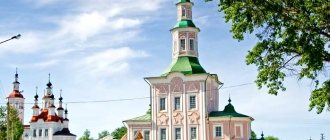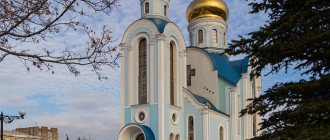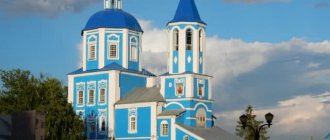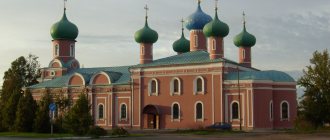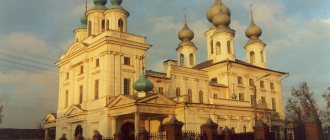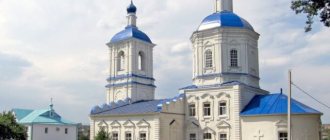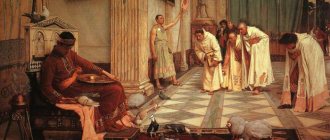| Rostov-on-Don Mother of God-Nativity Cathedral |
Rostov and Novocherkassk Diocese
of the Don Metropolis of the Russian Orthodox Church
- Diocesan administration: Russia, 344002, Rostov-on-Don, st. Stanislavsky, 58
- Tel.
- Official site:
- Canonical territory: Rostov-on-Don, Azov, Bataysk, Novocherkassk and Taganrog districts; Azov, Aksai, Kuibyshev, Matveevo-Kurgan, Myasnikovsky and Neklinovsky districts of the Rostov region
- Cathedrals: Mother of God of the Nativity in Rostov-on-Don, Ascension in Novocherkassk
- On the map: Yandex.Map, Google map
Established on May 24, 1919, being separated from the Ekaterinoslav diocese.
The decision to allocate a diocese was made at the Stavropol Council (May 19-May 24, 1919) designed to organize a Temporary Higher Church Administration for parts of the Russian Orthodox Church that found themselves in the territory occupied by Denikin’s white troops [1].
After the capture of the Don by the Bolsheviks in early 1920, persecution of the Church began here. A commission was created to implement the Decree “On the Separation of Church and State,” whose activities were, in particular, aimed at closing churches. By 1920, 4 churches were closed in Rostov; in 1923, it was decided to close three more: Archangel Michael, Vladimir and Catherine. Due to the disruption by the indignant people of the action to confiscate church valuables in Rostov on March 11, 1922, 37 people were arrested, among whom were Bishop Arseny (Smolenets) of Rostov, 7 priests, 4 members of the parish council and the cathedral audit commission.
From 1922 to 1937 there was also a renovationist diocese of Rostov-on-Don.
In 1937, the Rostov Cathedral was closed. However, already in 1942, during the fascist occupation, it opened again and henceforth remained operational
In 1943, after the liberation of Rostov, the territory of the closed Don Diocese was included in the Rostov diocese.
As of 2005, the diocese united parishes and monasteries in the Rostov region. On July 27, 2011, the Shakhty and Volgodonsk dioceses were separated from Rostov, after which Rostov-on-Don, Azov, Bataysk, Novocherkassk and Taganrog city districts, as well as Azov, Aksai, Kuibyshev, Matveevo-Kurgan, Myasnikovsky remained under the jurisdiction of the Rostov department and Neklinovsky districts in the west of the Rostov region. On October 6, 2011, the Rostov-on-Don diocese became part of the Don Metropolis.
Historical names
- Rostov (on-Don) and Taganrog (May 24, 1919 - mentioned April 24, 1929)
- Rostov and North Caucasus (mentioned 1943) [2]
- Rostov-on-Don and Novocherkassk (August 5 - August 10, 1943) [2]
- Rostov-on-Don (August 10, 1943 - 1944) [2]
- Rostov and Taganrog (1944 - mentioned April 14, 1946)
- Rostov and Novocherkassk (February 24, 1948 - 1954)
- Rostovskaya and Kamenskaya (1954 - December 26, 1957)
- Rostov and Novocherkassk (from December 26, 1957)
Statistics
- January 1, 1958 - 213 registered temples/houses of worship [3]
- 1986 - 64 registered communities [4]
- 1991 – 112 registered communities [4]
- 1994 – 200 registered communities [5]
- 2005 - 253 parishes were registered (divided into 16 deaneries), all parishes had churches or houses of worship; there were 3 monasteries (2 men's, 1 women's), the Rostov branch of the Moscow St. Tikhon's Humanitarian University (209 people studied in five courses), the Rostov Theological School of a missionary orientation (30 people studied), 8 spiritual and educational centers, more than 60 Sunday schools In addition to the two main publications of the diocese (“Church Bulletin” and “Svechechka”), 7 deaneries published small newspapers with a circulation of several hundred copies. The diocese had its own printing house and television studio “Orthodox Don,” diocesan and 6 dean’s Internet sites.
In addition to the Orthodox, in the Rostov region there were 219 religious organizations of 32 faiths, 15 missionary and charitable structures registered with the justice authorities. The regional and North Caucasian leadership centers of 13 non-Orthodox religious associations were located in the city. Of these: “Union of Churches of Evangelical Christian Baptists” - 44 communities have 27 houses of worship, the rest rent premises from fellow believers; “Christians of the Evangelical Faith” (Pentecostals) of various organizational subordination - 43 organizations, most of them rent premises; Seventh-day Adventists - 34 communities, have 30 houses of worship; “Jehovah's Witnesses” - 18 communities, organizationally united in two districts, have several houses of worship; Islam - 17 organizations, united in two Muslim departments, there are 3 mosques, 2 of them in adapted buildings; Judaism - 7 communities (5 Hasidic, 1 progressive, 1 Orthodox), Hasidim have 1 synagogue, one yeshiva (40 people studied), one secondary school; Roman Catholicism - 5 parishes, 1 temple, 1 convent; Armenian Apostolic Church – 3 parishes; Molokans – 6 autonomous communities; “Church of Jesus Christ of Latter-day Saints” (Mormons) – 5 communities, have 5 premises. Most Protestant organizations operated Bible schools.
In addition to these religious organizations, according to expert estimates, there were more than a hundred religious groups operating in the region. Some, such as Separate Baptists, do not register as a matter of principle. Some were registered, but of their own free will did not re-register due to the burdensomeness of registration and obligations of legal entities (Methodists, Presbyterians, Molokans, Doukhobors, “Church of Christ”, Buddhists, Pentecostals, “Free Russian Orthodox Church”, Hare Krishnas, Baha’is, Moonies, Scientologists , followers of the transcendental meditation technique, etc.). For the same reason, many religious associations, along with registered religious organizations, have “daughter” religious groups: small parishes of the Russian Orthodox Church of the Moscow Patriarchate, Old Believers, Baptists, Pentecostals, Mormons, Jehovah’s Witnesses, Evangelical Christians, Adventists, the Salvation Army, etc.
Most religious organizations maintained international ties and contacts; the most active in this regard were Mormons, Jews, Baptists, Pentecostals, Catholics, Adventists, Jehovah's Witnesses, and Muslims. In the region there were foreign clergy, preachers, missionaries, representatives of various charitable religious foundations, teachers of Bible schools and others [6].
- November 2011 - 121 parishes (in 6 deaneries, of which 2 monasteries); 2 monasteries (1 male, 1 female); 187 full-time clergy (45 archpriests, 111 priests, 1 protodeacon, 18 deacons); 12 monastics (1 archimandrite, 3 abbots, 5 hieromonks, 3 hierodeacons) [7]
Archpastors
- Arseny (Smolenets) (May 24, 1919 - November 1, 1927)
- Seraphim (Silichev) (March 12, 1922 - 1922) high school bishop. Alexandrovsky
- Seraphim (Silichev), 2nd time (July - October 27, 1927) in/u, ep. Azov
- Nikolai (Amasia) (November 30, 1931 - November 22, 1933) v/u, bishop. Yeisk
- Sergius (Petrov) (August 1961 - January 12, 1962) high school bishop. Voronezh
- Alexy (Konoplev) (December 15, 1966 - October 7, 1967) v/u, archbishop. Krasnodar
Story
The Don Cossacks spread the Orthodox faith throughout the south of the Russian Empire - they began to populate the desert lands of the hot south and build an Orthodox church in every military settlement - so quite quickly a whole network of military chapels grew up here. Initially, all local parishes were subordinate to the Sarsk diocese, but after the official annexation of the Cossack Land to the Russian Empire through the efforts of Peter the Great, part of the lands became part of Ryazan and Voronezh.
Rostov Cathedral of the Nativity of the Blessed Virgin Mary
Officially and for the first time, the bishop's chair was located in the Rostov region (the city of Novocherkassk) on April 5, 1829 - it was then that Emperor Nicholas I signed the corresponding decree. The status of the local bishop sounded like “Donskoy and Caucasian”, and the diocese itself began to belong to the honorary second class until the abolition of the statuses in 1867. The first official Don diocese included the Black Sea Army and the Caucasus region.
In 1842, a transformation took place, and the Caucasus region separated, becoming an independent unit within the Russian Orthodox Church. The diocese began to be called Rostov and Novocherkassk, its borders coincided with the administrative territory of the Don Army Region, which made it one of the largest in the empire.
During the period of the revolution and the beginning of church repressions, Orthodoxy in Rostov experienced difficult years - the bishop was sent into exile in 1922, churches were closed and destroyed, church valuables were looted. By 1940, about 620 churches and all existing monasteries were closed.
Temple of the Kazan Icon of the Mother of God in Rostov-on-Don
During the celebration of the 1000th anniversary of the baptism of Rus' in 1988, only 77 parishes operated here, half of them in adapted premises. The remaining 149 churches in the region were used as museums and were architectural monuments; worship services in them were prohibited.
Geography of deaneries
- Rostov Central, Rostov Eastern, Rostov Western, Rostov Northern (Rostov-on-Don):
- Rostov-on-Don
- Azov city, village Alexandrovka, Bataysk, village. Vysochino, s. Zaimo-Obryv, s. Kagalnik, s. Kuleshovka, Krasny Sad settlement, village. Krugloe, s. Novo-Nikolaevka, x. Obukhovka, village Peshkovo, s. Port Caton, s. Samara, village Seven beams
- Aksai city, x. Bolshoy Log, st. Grushevskaya, st. Mishkinskaya, st. Olginskaya, h. Ostrovsky, village Rassvet, st. Starocherkasskaya
- p. Matveev-Kurgan, p. Agrafenovka, s. Alexandrovka, s. Alekseevo-Tuzlovka, village. Anastasievka, h. Bolshaya Kirsanovka, village. Generalskoe, village Grekovo-Timofeevka, village. Grigorievka, s. Ekaterinivka, h. Kamenny Brod, village Kryukovo, s. Kuibyshevo, s. Latonovo, s. Novonikolaevka, village. Politotdelskoye, village. Mummer
- X. Kalinin, s. Nedvigovka, lyrics. Petrovka
- Novocherkassk
- Taganrog, s. Andreevo-Melentyevo, p. Varenovka, village Vasilyevo-Khanzhonovka, village. Veselo-Voznesenka, x. Red Landing, p. Lakedemonovka, village. Natalevka, s. Nikolaevka, s. Novobessergenevka, village. Pokrovskoe, village Primorka, s. Sinyavskoe, village Troitskoe, s. Fedorovka
Russian Orthodox Church
Part of the Don Metropolitanate
Since the end of the 14th century, the Don Army Region was part of the Voronezh diocese. Later, the Don land was under the direct care of the Patriarch of Moscow and All Rus'. On March 8, 1718 (old style), the Don parishes re-entered the Voronezh diocese. On April 5, 1829, an independent Novocherkassk and St. George diocese was established, separated from the Voronezh one. On July 17, 1842, the Caucasian diocese was separated from Novocherkassk - on the lands of the Black Sea Cossack army and the North Caucasus. The Novocherkassk and St. George diocese was renamed the Don and Novocherkassk diocese (abolished in 1942). In 1943 the diocese was restored as Rostov-on-Don. In 1943-1948. was called Rostov and Taganrog, in 1949-1954. - Rostov and Novocherkassk, in 1954-1957. - Rostovskaya and Kamenskaya, since 1957 - Rostovskaya and Novocherkasskaya.
By the decision of the Holy Synod of July 27, 2011 (magazine No. 70), the Shakhty and Volgodonsk dioceses were separated from the Rostov diocese. By the decision of the Holy Synod of October 5-6, 2011 (magazine No. 132) it was included in the Don Metropolis.
Diocese today (as of March 2013)
Deaneries and deaneries
Rostov-on-Don:
- Eastern - Archpriest Dimitry Osyak
- Western - Archpriest John Osyak
- Northern - Archpriest Alexander Pyatnitsky
- Central - Archpriest Gennady Makarenko
- Azov - Archpriest Vladimir Udovenko
- Aksai - Archpriest Alexander Budkov
- Kuibyshevskoye - Priest Maxim Vishnevsky
- Matveevo-Kurgan - Priest Igor Milyaev
- Myasnikovskoe - Priest Georgy Pnevsky
- Novocherkassk - Archpriest Oleg Dobrinsky
- Taganrog - Archpriest Alexy Lysikov
Monasteries
- Svyato-Donskoy Starocherkassk men's Rostov region, Aksai district, art. Starocherkasskaya, st. Pochtovaya, 1st viceroy - Abbot Macarius (Zelenkov)
- Rostov St. Iveron Women's 344052, Rostov-on-Don, st. Neklinovskaya, 4; tel. (8632) 35-41-63 abbess - abbess Rachel (Kovalyova)
The number of parishes is 131, including 2 monasteries.
The number of full-time clergy is 228, including:
- archpriests - 49;
- priests - 141;
- protodeacons - 1;
- deacons - 15.
monastics , including:
- archimandrites - 1;
- abbots - 4;
- hieromonks - 11;
- hierodeacons - 5.
Social projects
In all deaneries there are charity canteens and points for receiving and distributing things. Also, in most deaneries there are parish sisterhoods that serve in social and medical institutions and at home (care for the elderly, disabled, etc.). Training courses for Orthodox sisters of mercy have been organized at the St. George's Church in Rostov-on-Don.
Diocesan media
printed publications:
- "Bulletin of the Don Metropolitanate" (quarterly publication)
- tab in the regional newspaper “Hammer” (a joint project with the Synodal Information Department)
Internet sites:
- website of the Rostov-on-Don diocese
TV:
- TV studio "Orthodox Don"
Educational establishments
- Don Theological Seminary 344044, Rostov-on-Don, st. Portovaya, 72; tel. (863) 269-42-52; website donseminary.ru; e-mail,
Current situation
Since the beginning of the 90s, the Russian Orthodox Church began to return its property and gradually restore churches. Since 1982, Metropolitan Vladimir (Sabodan) began large-scale work to revive Orthodoxy in the region. It was through his efforts that the first monastery was opened, Orthodox media began to be published, and after his transfer in 1992, this work was continued by his successors, who occupied the department of metropolitan and bishop.
Over the past 20 years, parishes and churches have been actively restored in the region, Orthodox educational institutions have been opened, monasteries have been created, and new ministries have begun among the local population, which during the atheistic state did not have the opportunity to hear the Gospel.
Church of the Ascension of the Lord, Rostov-on-Don
Some of the most outstanding events were:
- Opening of the Rostov Theological School - it opened in 1993, and was later renamed the Don Theological Seminary. Future theologians and clergy are trained here in various fields.
- Creation of the Holy Don Starocherkassky Monastery - it opened on the territory of the abandoned Ephraim Convent in 1994.
- The beginning of the Dmitriev readings - held annually in Rostov for a meeting of clergy with representatives of the teaching community of the region and students.
The clergy carry out extensive work with young people, so as part of an experiment, the basics of Orthodox culture began to be taught in secondary schools. Churches run Sunday schools for children and adults.
The growth of parishes led to the fact that in 2011 the Holy Synod decided to grant independence to the dioceses of Shakhtinskaya and Millerovskaya and Volgodonskaya and Salskaya. And in the fall of the same year, the decision was made to create the Don Metropolis.
Composition and activities
Today the Rostov diocese includes 12 deaneries, 4 of which are located in the city of Rostov-on-Don. In total, the current Metropolitan Mercury (Ivanov) governs 131 parishes, of which 2 belong to monasteries. There are 228 full-time clergy, and 21 monastics.
Metropolitan of Rostov and Novocherkassk Mercury
The clergy here carry out a number of social projects, whose goal is to attract the laity into the Bosom of the Church and their churching. Among the most extensive and ongoing projects:
- Charitable canteens for people in need and the homeless.
- Distribution of humanitarian aid in parishes.
- Sisterhood that works on the basis of social and medical institutions.
- Work with young people, which includes lessons on the basics of Orthodox culture in schools and regular meetings with students.
Much attention is paid to the media - an Orthodox multi-page magazine is published monthly in the region, and Novocherkassk publishes its own newspaper. The diocese website and pages on social networks are active. It has its own television studio, “Orthodox Don,” where all Orthodox television programs for regional broadcasting are filmed.
Extensive work with the population is carried out thanks to the diocesan departments, of which there are 11. Among them are information and publishing, social ministry, education and catechesis, etc.
Churches and monasteries
The Metropolitan's See is located in Rostov-on-Don, and there are two cathedrals in the diocese:
- Ascension Cathedral, which stands in the historical center of the diocese, the city of Novocherkassk. Mention of the temple was first found in documents of 1805; its architect was Aloysius Ruska. The cathedral was built in a classical style and was first opened to parishioners only in 1905. The Bolsheviks, after looting the cathedral, closed it and used it as a warehouse. It was reopened by the Germans for worship, and after the occupation, the upper tiers were used for liturgies, and the lower ones as a warehouse for food. The last restoration was completed by 2005, and in 2011 it became the second Patriarchal Council of the country.
Holy Ascension Cathedral in Novocherkassk - Cathedral of the Nativity of the Blessed Virgin Mary, which is located in the current cathedral city of Rostov. It was built in 1854 and is the hallmark of the city - it is depicted on almost all souvenir products in Rostov. The architect was K. Thon and this cathedral is very similar to his other works, in particular with the Cathedral of Christ the Savior in Moscow. During the Soviet period, the church building was transferred to the city circus, and services there were resumed only during the German occupation. After the war, the temple was restored and used for liturgies. The bell tower was completely restored only in 2011.
There are two monastic metochions on the territory of the diocese:
- Donskoy Starocherkassky Men's Monastery was established in 1994 on the site of the closed old Efremovsky Convent. The rector is Hieromonk Sergius, and in total 25 monks live in the monastery.
- Iversky Women's - was founded in 1903, at the expense of the Rostov merchant Fedorov. After the revolution, the monastery existed for several years as an officially registered agricultural artel, but was closed in 1929. Buildings were destroyed, households were dismantled or destroyed, many sisters were exiled to Siberia, like Mother Superior Anastasia. The monastery was restored in 1991. Currently, 35 nuns live there under the leadership of Abbess Rachel.
Holy Iversky Convent of Rostov
On a note! You can visit all the sights within one pilgrimage trip to the south of Russia.
